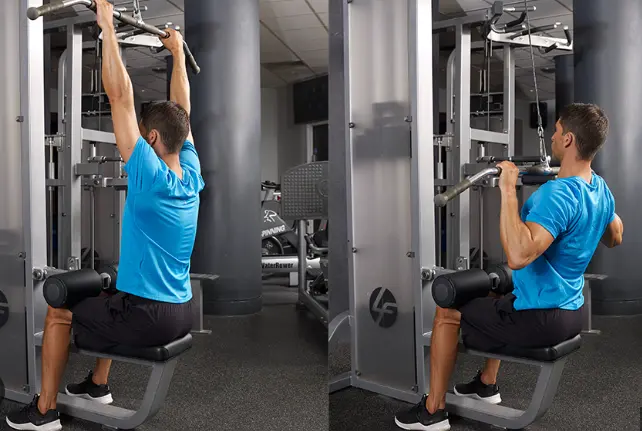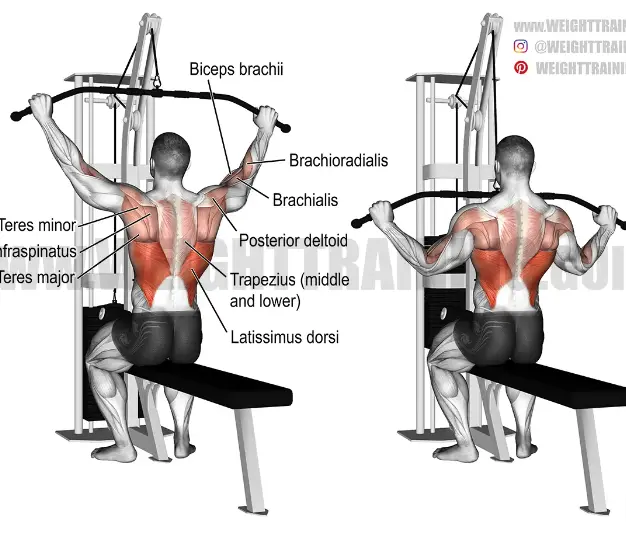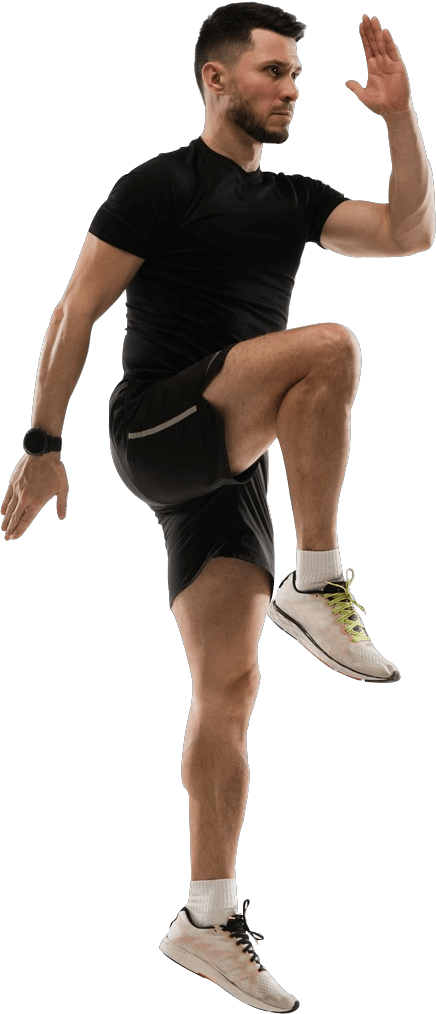Welcome to the world of strength training, where empowering your body is just a pulley away!
The LAT pulldown machine might have captured your attention among the array of gym equipment. This powerhouse exercise is designed to target your back, shoulders, and arms, offering the key to unlocking a sculpted upper body and newfound strength.
Whether you’re new to the gym and eager to learn or a seasoned fitness enthusiast looking to refine your technique, this article has got you covered.
We’ll take a deep dive into the mechanics of the LAT pulldown, its common errors and variations providing you with expert guidance and tips to master this game-changing workout.

How to do a LAT pulldown
Step 1: Adjust the Machine
- Sit on the lat pulldown machine and adjust the thigh pads so they comfortably rest on your thighs, securing your lower body in place. Adjust the seat height so that your feet are flat on the ground and your knees are at a 90-degree angle.
Step 2: Hand Position
- Grasp the wide bar or handles of the pulldown machine with an overhand grip (palms facing away from you) slightly wider than shoulder-width apart. Your hands should be positioned symmetrically on the bar, and your wrists should be in a neutral position.
Step 3: Starting Position
- Sit upright with your chest lifted, shoulders relaxed, and your back slightly arched. Keep your core engaged for stability throughout the exercise.
Step 4: Initiating the Movement
- Inhale and depress your shoulder blades (pull them down and back) while slightly leaning back. This is your starting position.
Step 5: Pulldown Motion
- Exhale and initiate the movement by pulling the bar down towards your upper chest. Focus on engaging your lats (the large muscles in your back) and squeezing your shoulder blades together as you bring the bar down.
Step 6: Lowering the Weight
- Inhale as you slowly and with control, let the bar return to the starting position, extending your arms fully but keeping a slight bend in your elbows to avoid locking them out.
Step 7: Repetitions and Sets
- Aim for 10 to 15 repetitions in each set. Start with a weight that allows you to perform the exercise with proper form and gradually increase the weight as you become more comfortable and stronger.
- Complete 3 to 4 sets of lat pulldowns, resting for about 1-2 minutes between each set.
Step 8: Pro Tips
- Avoid using momentum to swing the weight up and down. Focus on a slow and controlled movement to target the intended muscles effectively.
- Keep your chest lifted and avoid rounding your back during the exercise to prevent strain on your spine.
- If you experience any pain or discomfort, stop the exercise immediately and consult a fitness professional or a healthcare provider.
You might wanna know how to do the leg curls
What muscles are targetted in the LAT pulldowns

The main muscles targeted in lat pulldowns include:
Latissimus Dorsi (Lats): These are the broad muscles that run down the sides of your back, extending from the upper arm to the lower back. They are the primary muscles engaged during lat pulldowns and are responsible for the pulling motion.
Rhomboids: Located between the shoulder blades, the rhomboids help retract and stabilize the scapula (shoulder blades) during the movement.
Trapezius (Traps): The traps are located on the upper back and neck. They assist in shoulder movement and provide stability during the lat pulldown exercise.
Posterior Deltoids: The rear deltoid muscles are situated at the back of the shoulders. They help to extend and stabilize the shoulder joint during the pulling motion.
Biceps: While the lats are the primary movers, the biceps brachii in the upper arms assist in the pulling motion.
Forearms: The muscles in the forearms, particularly the brachioradialis and brachialis, are engaged as they help to stabilize the wrists during the exercise.
Lower Trapezius: The lower fibres of the trapezius muscles also contribute to the stabilization of the shoulder blades during the lat pulldown.
Related Articles:
Benefits of LAT Pulldown
The lat pulldown exercise offers numerous benefits for upper body strength and overall fitness. Here are 5 key advantages of including lat pulldowns in your workout routine:
Strengthening the Latissimus Dorsi: As the name suggests, lat pulldowns primarily target the latissimus dorsi muscles, helping to develop a strong and well-defined back.
Improved Upper Body Strength: Lat pulldowns engage multiple muscles in the back, shoulders, and arms, leading to enhanced upper body strength and power.
Better Posture: Strengthening the back muscles, including the lats and rhomboids, can help improve posture and reduce the risk of slouching or rounded shoulders.
Compound Movement: Lat pulldowns are a compound exercise, meaning they involve multiple joints and muscle groups, leading to efficient calorie burning and overall body engagement.
Muscle Symmetry: Including lat pulldowns in your routine can help achieve better muscle symmetry between the left and right sides of your upper body.
Related: the proper way to train glutes
How to do lat pulldowns at home
Here are ways to perform a lat pulldown at home without the lat pulldown machine:
- Resistance Bands Lat Pulldown:
- Secure a long resistance band to a sturdy anchor point above you, such as a doorframe or a pull-up bar.
- Sit or kneel on the floor and grasp the resistance band with an overhand grip, slightly wider than shoulder-width apart.
- Pull the band down towards your chest while squeezing your shoulder blades together, mimicking the lat pulldown motion.
- Slowly release the band to return to the starting position and repeat for the desired number of repetitions.
- Towel Lat Pulldown:
- Tie a large towel or bedsheet around a horizontal bar or any sturdy anchor point above you.
- Stand or kneel facing the anchor point and hold the towel with an overhand grip.
- Pull the towel down towards your chest, engage your back muscles, and slowly release to return to the starting position.
- Control the movement throughout the exercise to maintain tension in your back muscles.
- Inverted Row:
- Lie on your back under a sturdy horizontal bar (e.g., a table, sturdy desk, or low bar in a playground).
- Grasp the bar with an overhand grip, hands slightly wider than shoulder-width apart.
- Lift your chest towards the bar, squeezing your shoulder blades together, and lower yourself back down with control.
- You can adjust the difficulty by changing your body angle: the more horizontal your body, the harder the exercise.
- Doorframe Lat Pulldown:
- Use a doorframe pull-up bar or a sturdy overhead bar attached to a doorway.
- Stand facing the doorframe, and grasp the bar with an overhand grip.
- Step back to create tension in your arms and engage your back muscles.
- Pull your chest towards the bar, focusing on squeezing your shoulder blades together, and then lower yourself back down.
11 Common errors in performing the LAT pulldown

Here are 11 common mistakes to avoid:
Using Momentum: Swinging or using momentum to pull the weight down takes the focus away from the targeted muscles (lats) and reduces the effectiveness of the exercise. Instead, maintain a controlled and steady movement throughout the entire range of motion.
Insufficient Range of Motion: Failing to fully extend your arms at the top of the movement or not pulling the bar down towards your chest completely limits the engagement of the lats. Make sure to go through the full range of motion for maximum muscle activation.
Rounding the Back: Arching or rounding your back during the lat pulldown can put unnecessary stress on your spine and reduce the effectiveness of the exercise. Keep your back straight and engage your core for stability.
Gripping Too Narrow or Wide: Gripping the bar too narrow or too wide can alter muscle engagement and put a strain on the shoulders and wrists. Aim for a grip that is slightly wider than shoulder-width apart to target the lats effectively.
Pulling with the Arms: The primary focus of the lat pulldown should be on using the lats to pull the bar down, not relying solely on the arms. Initiate the movement from the back muscles, specifically the lats.
Not Engaging the Shoulder Blades: Neglecting to engage the shoulder blades (scapulae) and pulling them down and back reduces the involvement of the lats. Focus on squeezing the shoulder blades together as you pull the bar down.
Lifting the Hips: Lifting the hips or using the lower back to assist in pulling the bar down compromises the integrity of the exercise. Keep your lower body stable and avoid any swinging or lifting of the hips.
Using Excessive Weight: Using a weight that is too heavy can lead to improper form and potential injury. Start with a manageable weight that allows you to perform the exercise with the correct technique and gradually increase as you progress.
Neglecting the Negative Phase: The lowering phase of the exercise (eccentric) is equally important as the pulling phase. Control the bar as you release it back to the starting position rather than letting it drop quickly.
Breathing Incorrectly: Failing to coordinate your breathing can disrupt your performance. Exhale as you pull the bar down and inhale as you release it back up.
Elbows flaring out: What most people get wrong is that they keep their elbows at a 90-degree angle from their body which can cause shoulder injury. Therefore, the correct way is to have your elbows tucked in so that they are 45-60 degrees from your body.
FAQ’S

How to do lat pulldowns for beginners?
To start lat pulldowns as a beginner, follow these steps: Sit on the machine, adjust the thigh pads, and grasp the bar with an overhand grip. Keep your back slightly arched, chest lifted, and pull the bar down towards your upper chest while squeezing your shoulder blades together. Then, slowly release it back up. Maintain a controlled motion, engage your lats, and focus on your form.
What muscles do the lat pulldown work?
The lat pulldown primarily targets the latissimus dorsi muscles (lats), which are the broad muscles on your back. It also engages the rhomboids, traps, posterior deltoids, biceps, and forearms for a comprehensive upper-body workout.
Why can’t I feel my lats?
If you can’t feel your lats during lat pulldowns, you might be using incorrect form or not engaging them properly. Focus on pulling with your back muscles, initiate the movement from your lats, and squeeze your shoulder blades together at the bottom of the motion.
Should I lean back during lat pulldown?
It’s advisable to lean slightly back during lat pulldowns to engage your lats more effectively. However, avoid excessive leaning, as it can strain your lower back. Find a comfortable angle where you can engage your lats while maintaining proper posture.
How do I target my lats more on pulldown?
To target your lats more during lat pulldowns, focus on pulling the bar down using your lats instead of your arms. Initiate the movement by depressing your shoulder blades and squeezing them together at the bottom of the motion. Lean back slightly to maximize lats engagement.
How can I target my lats better?
To better target your lats, concentrate on proper form. Use a controlled motion, engage your lats to initiate the pull, and squeeze your shoulder blades together at the end of the movement. Experiment with grip width and slightly leaning back to optimize lats activation. Gradually increase weight as your strength improves.
Conclusion
In conclusion, mastering the art of the LAT pulldown opens the door to a stronger, more defined upper body. By understanding the correct form, engaging the right muscles, and avoiding common pitfalls, you’re well on your way to achieving your fitness goals.
Whether you’re a beginner seeking to build a foundation or a seasoned fitness enthusiast aiming to refine your technique, the LAT pulldown offers benefits aplenty.
So, let’s put this knowledge into action! Grab that bar, focus on your lats, and pull with confidence. Remember, progress takes time and dedication, but each repetition brings you closer to a more sculpted back, improved posture, and enhanced upper body strength.
Now, it’s over to you. Hit the gym or set up your home workout space, and incorporate the LAT pulldown into your routine. Your lats are waiting for the challenge – embrace it and take your fitness journey to new heights!

